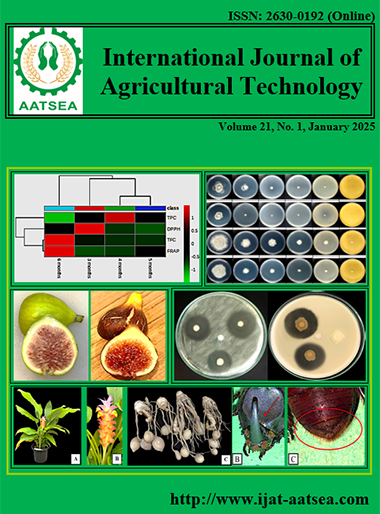Factors affecting the adoption of smart root washing innovation by commercial vegetable growers in the eastern suburbs of Bangkok, Thailand
Main Article Content
Abstract
Result showed that 70% of the participa. nts were male, and the majority cultivated leafy vegetables. Natural canals emerged as the primary water source, with manual labour being the dominant washing method. All farmers washed vegetables manually, and 73.3% reported inadequate cleaning as their main post-harvest challenge. The adoption of the smart root washer received a moderate perceived utility score of 3.44, mirroring ratings for ease of use/complexity (mean=3.45). There was a consistent moderate perception across other adoption parameters, including observability (mean=3.44) and risk (mean=3.45). The technology’s adoption trajectory encompassed knowledge, persuasion, decision-making, implementation, and confirmation stages, registering moderate acceptance levels, with scores ranging between 3.28 and 3.45. Gender was the strongest predictor across all models, with the persuasion model having the highest absolute Beta coefficient (β=0.673). The consistent significance of gender differences suggested to play a crucial role in the adoption process.
Article Details

This work is licensed under a Creative Commons Attribution-NonCommercial-NoDerivatives 4.0 International License.
References
Agricultural Research Development Agency (2018). Agricultural Technology for Improving Efficiency in the Agricultural Sector. Retrieved from https://www.arda.or.th/detail/6182
Ali, D. A., Bowen, D. and Deininger, K. (2020). Personality Traits, Technology Adoption, and Technical Efficiency: Evidence from Smallholder Rice Farms in Ghana. Journal of Development Studies, 56:1330-1348.
Anand, J., McDermott, G., Mudambi, R. and Narula, R. (2021). Innovation in and from emerging economies: New insights and lessons for international business research. Journal of International Business Studies, 52:545-559.
Anwar, M., Zulfiqar, F., Ferdous, Z., Tsusaka, T. W. and Datta, A. (2021). Productivity, profitability, efficiency, and land utilization scenarios of rice cultivation: An assessment of hybrid rice in Bangladesh. Sustainable Production and Consumption, 26:752-758.
Asian Development Bank (2022). The Social Protection Indicator for Asia: Tracking Developments in Social Protection (0 ed.). Asian Development Bank. Retried from https://doi.org/10.22617/SGP220562-2
Cavite, H. J., Kerdsriserm, C., Llones, C., Direksri, N. and Suwanmaneepong, S. (2022). Farmers’ perception of consumer information and adoption intention towards organic rice farming: Evidence from community enterprise in rural Thailand. Outlook on Agriculture, 003072702211352. https://doi.org/10.1177/00307270221135250
Chinseu, E. L., Dougill, A. J. and Stringer, L. C. (2022). Strengthening Conservation Agriculture innovation systems in sub-Saharan Africa: Lessons from a stakeholder analysis. International Journal of Agricultural Sustainability, 20:17-30.
Cremades, R., Wang, J. and Morris, J. (2015). Policies, economic incentives and the adoption of modern irrigation technology in China. Earth Syst. Dynam, 6:399-410.
Ebers, A., Trung, Nguyen, T. and Grote, U. (2017). Production efficiency of rice farms in Thailand and Cambodia: A comparative analysis of Ubon Ratchathani and Stung Treng provinces. Paddy and Water Environment, 15. https://doi.org/10.1007/s10333-016-0530-6
Fosso, P. K. and Nanfosso, R. T. (2016). Adoption of agricultural innovations in risky environment: The case of corn producers in the west of Cameroon. Review of Agricultural, Food and Environmental Studies 2016 97:1, 97:51-62.
Gonzalvo, C. M., Tirol, M. S. C., Moscoso, M. O., Querijero, N. J. V. B. and Aala, W. F. (2020). Critical factors influencing biotech corn adoption of farmers in the Philippines in relation with the 2015 GMO Supreme Court ban. Journal of Rural Studies, 74:10-21.
Hasan, I., He, Q. and Lu, H. (2020). The impact of social capital on economic attitudes and outcomes. Journal of International Money and Finance, 108, 102162. https://doi.org/10.1016/j.jimonfin.2020.102162
Jaikhun, M. and Phothongsaengarun, R. (2019). Technology acceptance, trust, and social media marketing affecting purchase intention through Facebook LIVE among generation X, Y, Z consumers. Academic Journal of Suvarnabhumi Institute of Technology, 5:260-275.
Kelly, S., Kaye, S. and Oviedo-Trespalacios, O. (2023). What factors contribute to the acceptance of artificial intelligence? A systematic review. Telematics and Informatics, 77:101925.
Lee, S. M. and Trimi, S. (2018). Innovation for creating a smart future. Journal of Innovation & Knowledge, 3:1-8.
Likert, R. (1932). A technique for measurement of attitudes. Archives of Psychology, 140:5-55.
Llones, C., Mankeb, P., Wongtragoon, U. and Suwanmaneepong, S. (2021). Bonding and bridging social capital towards collective action in participatory irrigation management. Evidence in Chiang Rai Province, Northern Thailand. International Journal of Social Economics, 49:296-311.
Lorente, D., Aleixos, N., Gómez-Sanchis, J., Cubero, S., García-Navarrete, O. L. and Blasco, J. (2012). Recent Advances and Applications of Hyperspectral Imaging for Fruit and Vegetable Quality Assessment. Food and Bioprocess Technology, 5:1121-1142.
Mariano, M. J., Villano, R. and Fleming, E. (2012). Factors influencing farmers’ adoption of modern rice technologies and good management practices in the Philippines. Agricultural Systems, 110:41-53.
McHugh, M. L. (2013). The chi-square test of independence. Biochem Med (Zagreb), 23:143-149.
National Innovation Agency (2016 ). Innovative organization book of knowledge. Retrieved from https://ifi.nia.or.th/wp-content/uploads/2020/09/Innovative-Organization-BOOK_digital_09-2020.pdf
Oo, S. P. (2020). Farmers’ awareness of the low yield of conventional rice production in Ayeyarwady region, Myanmar: A case study of Myaungmya district. Agriculture, 10, 26. https://doi.org/10.3390/agriculture10010026.
Rakshit, S., Islam, N., Mondal, S. and Paul, S. T. (2022). An integrated social network marketing metric for business-to-business SMEs. Journal of Business Research, 150:73-88.
Rajkhowa, P. and Qaim, M. (2022). Mobile _off‐farm employment and household income in rural India.pdf.” Journal of Agricultural Eco-nomics 73:789-805. https://doi.org/10.1111/1477‐9552.12480.
Westermann, O., Forch, W., Thornton, P., Korner, J., Cramer, L. and Campbell, B. (2018). Scaling up agricultural interventions: case studies of climate-smart agriculture. Agricultural System, 165:283-293, 10.1016/j.agsy.2018.07.007
Zhou, J.-h., Li, K. and Liang, Q. (2015). Food safety controls in different governancestructures in china's vegetable and fruit industry. Journal of IntegrativeAgriculture 14:2189-2202.


